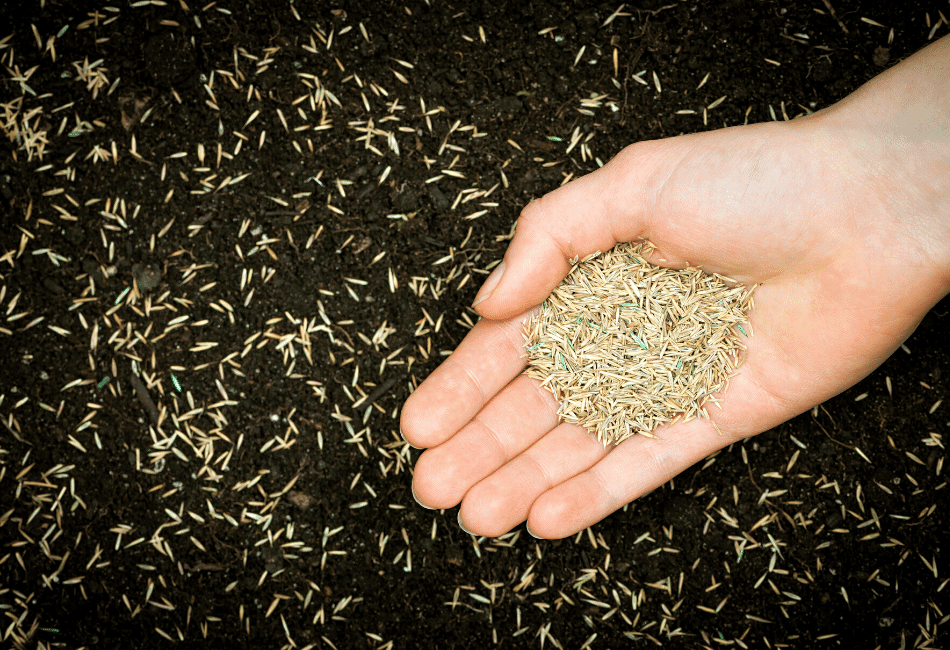The quick answer is no, grass seed does not need to be covered. We have successfully grown grass without covering the seed on several occasions. However, you should strongly consider covering your grass seed as we will explain below.
Before we discuss covering grass seed, we recommend following these basic steps to obtain success with seeding:
- Preparing the soil – You will not have good results if you plant grass seed in compact soil. The soil should be raked to loosen up a couple inches of the soil surface. This will allow the grass seeds to achieve adequate contact with the soil to eventually take root.
- Applying the seed – If you are seeding a large area, a spreader works best to evenly lay down the seed according to the manufacturer’s directions. If you do not have specific spreader settings for your seed, start by laying down minimal seed using a low spreader setting and gradually increase the spreading rate if needed. You always can go over an area with the spreader multiple times if required. However, if you spread the seed on too heavy, it is difficult to then manual adjust the seeded soil for the right amount of seed. When dealing with a small area, you can spread the seed by tossing it with your hand or by using a hand spreader.
- Seed-to-soil contact – Once the seed is on the soil, now it is time to gently rake it into the soil. We like to use the back of the rake to lightly skim the soil surface so that the seed works into the soil about 1/4 inch at maximum.
- Water – The soil surface should remain damp until the grass blades grow a couple of inches. This typically means watering twice a day for several weeks and adjusting for the weather (i.e. less or no water on raining days and potentially more water during hot and dry days).
Table of Contents
When To Cover Grass Seed
If it is in your budget, we recommend to always cover your grass seed. Grass seed is often expensive and covering it will help protect the seed from the potential problems discussed below.
- Heavy Bird /Animal Activity – Certain animals and birds will eat grass seed. We had a flock of birds have a feast on a seeded area for one of our small projects at home. The whole area required reseeding once the birds finished their buffett. Covering the seed will help deter birds and animals from seeing and reaching the seed for a quick meal. If you have heavy bird/animal activity in your area, it is smart to cover the your seed as a preventive measure.
- Windy Conditions – If you live in an area with heavy winds, covering the seed can help keep it in place. Grass seed that has been blown out of place will produced patchy or undesirable results.
- Hilly Terrain – When planting grass seed on a hill, it can be difficult to keep the seed from moving downhill. This is especially true when the seed is heavily watered (i.e. during a downpour) or when the wind picks up. Covering assists in keeping the seed in the soil where it is intended to be.
- Heavy Rains – Seed washout can occur when the seeded area quickly receives a lot of water, such as during a storm. The seed essential floats away to another area of the yard or maybe even out of the yard. A top covering of the seed helps the seed maintain its position.
- Hot Temperatures – Most people should be laying down grass seed in the spring or fall when temperatures are ideal for growing. However, there are times when the weather does not cooperate with our time frame for seeding. When the weather is extremely hot, covering the seed will shade the soil and help prevent it from drying out before the next watering session.
What To Use To Cover Grass Seed
Here are a few materials to consider using if you opt to cover your grass seed:
- Straw – You’ll often see landscape crews use straw to cover seed. It does a nice job as a cover but the problem with it is that it often contains weed seed. This, of course, is a problem since weeds will grow in along side your new grass. If you choose to use straw, order the kind that is 99% weed-free and biodegradable such as EZ-Straw.
- Peat Moss – This material is a good choice for not only helping retain moisture, but also for providing decent cover. However, it lightweight and tends to decompose quickly. You may need to reapply it if grass seed starts to become exposed. Read our article on peat moss for more information on this material.
- Lawn Mulch – Lawn mulches typically contain recycled paper, fiber, and the bonus of fertilizer. The mulch is biodegradable and swells with water to provide a nice, moist layer over the seed. An example of this type of product is Jonathan Green Top Dress. The downside to lawn much is that it isn’t cheap, making it impractical for some people seeding a large area on a tight budget.

